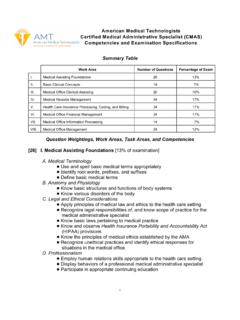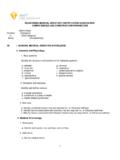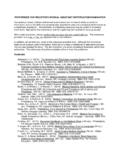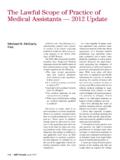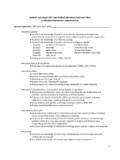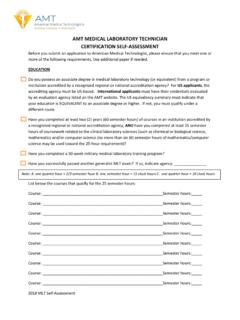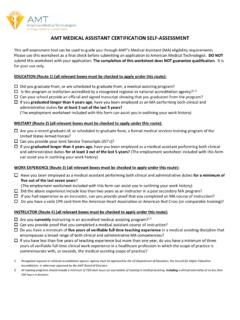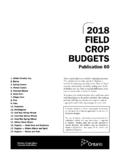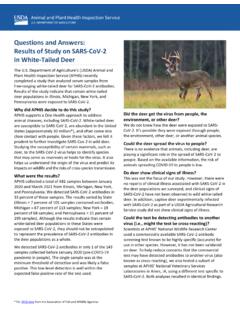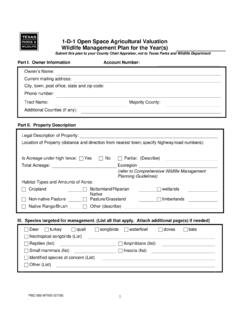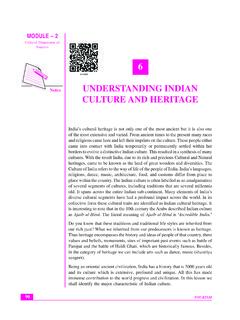Transcription of Elution Techniques in Blood Bank
1 28 January 2006 Continuing Education Topics & IssuesIntroductionThere are some terms used in association with elu-tion that individuals must be able to define and un-derstand. These terms include adsorption, Elution ,and absorption. Adsorption is the uptake of antibodyby cells. Elution is the removal of antibody fromcells. Absorption is the removal of antibody fromserum, usually by Techniques have a number of uses inblood bank including 1) separating a mixture of anti-bodies, 2) removing an autoantibody in order to de-tect presence of concomitant alloantibody, 3) remov-ing an unwanted antibody, 4) confirming presence ofspecific antigens on red cell membrane, and 5) con-firming specificity of is the process of removing antibodies fromthe surface of red Blood cells.
2 This can be accom-plished by a variety of Techniques that will be dis-cussed of Elution TechniquesPrior to performing an Elution , a direct antiglobu-lin profile (DAT) should be performed on the patient'sred Blood cells. If the DAT is negative or positive withcomplement only, the likelihood of retrieving an anti-body from the red cells is not likely. Thus, performingan Elution on cells with a negative DAT or sensitizedwith complement only is a waste of time, effort, andmoney in most instances. When the DAT is positivewith IgG antibody or IgG antibody and complement,an Elution may provide significant results. An elutionmay be indicated to aid in the 1) diagnosis of autoim-mune hemolytic anemia (AIHA), 2) diagnosis ABOhemolytic disease of the newborn (HDN), 3) identifi-cation of specificity when multiple antibodies existin a patient's serum or plasma, and 4) phenotypingred cells in patients with a positive of Autoimmune HemolyticAnemia (AIHA)Although the DAT provides useful information,the definitive diagnosis of AIHA is dependent uponthe characterization of the antibodies present in thepatient's serum and in the red cell eluate.
3 If the DAT ispositive, it is essential to remove the antibody fromthe cells and determine its , red cells with a negative antiglobu-lin test will provide a strongly reactive eluate. The an-tibodies that perform in this manner usually belongto Blood groups other than positive DAT with polyspecific AHG andmonospecific C3 indicates that the cells are coatedwith complement components only. Therefore, theeluate will produce negative results. These resultscould indicate the presence of a cold-reacting alloan-tibody that fixes complement, a cold-reacting autoan-tibody that fixes complement, or that complement isbeing fixed by the alternate or properdin pathway ofcomplement the DAT is positive with monospecific IgGAHG reagent, IgG antibody is sensitizing the redcells.
4 This IgG antibody can be eluted from the redcells and possibly identified by testing the eluateagainst a panel of phenotyped red cells. If the DAT ispositive due to IgG sensitization, yet the eluate showsno reactivity against normal phenotyped RBCs, drug-induced AIHA can be suspected or the antibody maybe against a low incidence antigen. This situation willrequire other Techniques in order to assign a speci-ficity to the involved antibody such as 1) investigatingpatient medication history to determine medicationsthat could be involved and following up with appro-priate testing with medication-coated red cells, and2) reacting mother's serum or baby's eluate with fa-ther's red cells to detect antibody to familial or lowincidence antigens causing of ABO Hemolytic Diseaseof the Newborn (HDN)One of the best diagnostic tests for ABO HDN isto prepare an eluate from the infant's red cells and testthat eluate against adult A and B cells because theDAT in ABO HDN may be weakly positive or evennegative.
5 The eluate will be negative with group Ored cells if the antibody(ies) involved are a part of theABO Blood group of Specificity when Multiple Antibodies Are PresentWhen multiple antibodies are encountered, selec-tive absorption and Elution may be used to separatethe mixture of antibodies. For example, initial anti-body screening results indicate the probable presenceof anti-C, anti-K, and anti-Jkb. The anti-C could beremoved from the patient's serum by absorbing theantibody onto cells that are phenotypically big C pos-itive, K negative, and Jkb negative. This would re-move the big C antibody which could then be elutedand identified in the eluate. A second adsorptioncould then be performed on the absorbed serum/plas-ma using K negative, Jkb positive red cells to removethe Jkb antibody and leave the K in the serum.
6 InGeorge H. Roberts,EdD, MT(AMT), Professor and Depart-ment Head, ClinicalLaboratory Science,The University ofLouisiana at MonroeArticle CECE lution Techniques in Blood BankGeorge H. Roberts Procedures for antigen-typing DAT-positive RBC Modified Heat Heat 450C with frequent agitation Heat causes thermal dissociation of AgAb complex without denaturing red cell membrane Rapid and easy. Some antigens may be damaged. RBC remain intact preparing DAT- positive RBC for antigen typing Chloroquine diphosphate Incubate 1 volume cells and 4 volumes chloroquine diphosphate Causes dissociation of immune complexes Requires two hour incubation Same as modified heatContinuing Education Topics & Issues January 2006 29some instances, rather than using multiple absorp-tions, the scientist may choose to use selected panelcells to demonstrate specificity in cases of accurately phenotype red cells withpositive DATWhen cells are heavily coated with IgG antibod-ies, tests with antisera of high protein content are dif-ficult and those with antiglobulin reactive antisera areimpossible.
7 It is necessary to dissociate antibody fromthe cell surface without damaging red cell integrityor altering antigenic reactivity. The desired end prod-uct is the red cell, not the antibody. As an example,in Rh and other forms of HDN (those due to antibod-ies other than Rh), the DAT may be positive due toblocking of the antigen sites by high titers of anti-body. For example, Rh positive red cells giving astrongly positive DAT may type as Rh negative due tothe blocking of Rh receptors. If an attempt is made toperform a weak D test, the test and the associated Rhcontrol will both be positive. This fact can be a seri-Q TECHNIQUE PROCEDURE ACTION ADVANTAGES/ DISADVANTAGES USES Temperature Landsteiner Heat Heat at 560C with agitation.
8 Spin and harvest eluate Heat causes thermal dissociation of AgAb complex and denatures cell membrane Rapid and easy. Eluate stained with hemoglobin. Less effective for warm auto/alloantibodies ABO antibodies Lui Freeze-Thaw Rapid freeze at 300C or lower. Rapid thaw at 370C. Spin and harvest eluate Rapid extremes in temperature cause the dissociation by change in red cell membrane structural configuration Same as heat ABO antibodies Ultrasonic Washed RBC in ultrasonic bath one minute, spin and harvest eluate Dissociation by shearing forces from high frequency sound waves and thermal energy produced by sonication Same as heat but needs special sonication device ABO antibodies Acid Elution Digitonin-Acid Digitonin lysis of RBC.
9 Wash yields a hemoglobin-free stroma. Add glycine buffer (pH ) to stroma. Readjust pH with phosphate buffer after Elution Acid alters charge of proteins causing a change in structural configuration Clear eluate. Slow process requiring many washes Most allo and autoantibodies. Decreased sensitivity for Kidd system Cold Acid Add cold (40C) glycine (pH ) directly to RBC. Incubate one minute at 40C. Spin and harvest eluate. Readjust pH with phosphate buffer Acid alters the charge of proteins causing a change in structural configuration Requires less time than digitonin. Eluate stained with hemoglobin. Less sensitive in eluting many alloantibodies Some alloantibodies and autoantibodies.
10 Organic Solvents Ether Mix ether, saline, and RBCs one minute. Vent, spin, and harvest eluate. Incubate 370C or 560C to drive off residual ether Denatures RBC membrane destroying structural conformation of lipid bilayer or may alter tertiary antibody structure Highly flammable and explosive. Must store in explosion-proof refrigerator Most alloantibodies and autoantibodies. Decreased sensitivity for Anti-S/s Xylene Mix cells and xylene and incubate at 560C for 10 xylene and stroma by vacuum aspiration. harvest eluate Same as ether Flammable, but does not require explosion-proof refrigerator. Requires vacuum aspiration Most alloantibodies and autoantibodies Chloroform Mix cells, albumin, and chloroform.
